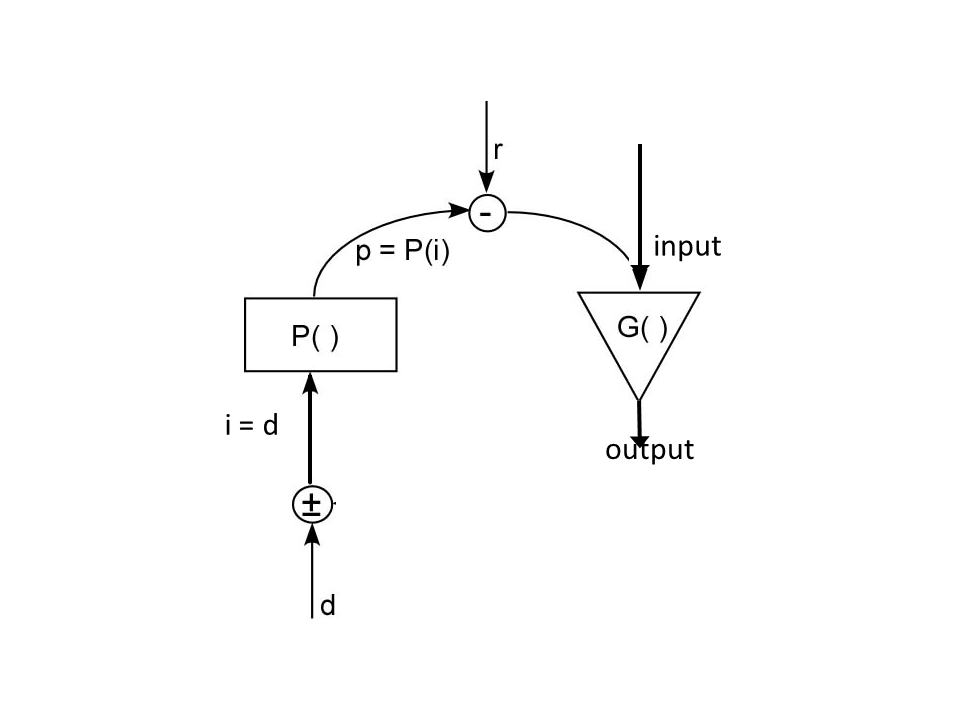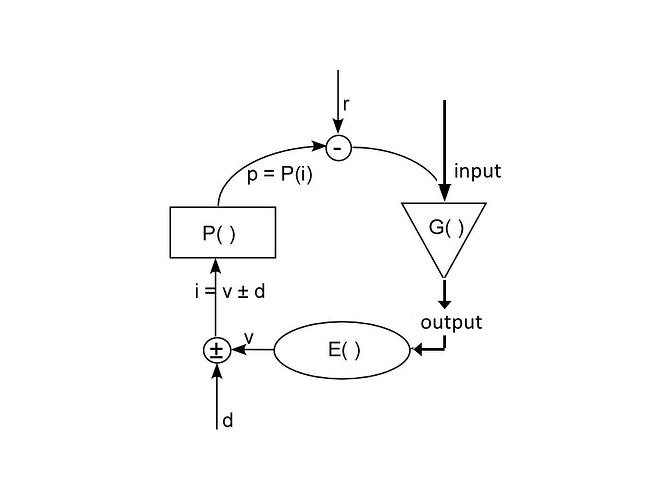[Martin Taylor 2014.03.14.12.20]
There is a VERY large literature on such experiments, going back
over a century. The experimenter (human or machine) did something
that might or might not influence some perception in the subject. Of
course, the subject could not control THAT perception, since there
would be no opportunity to influence the input that the experimenter
had already provided. But because the subject was controlling a
DIFFERENT and unrelated perception (perhaps a perception of the
experimenter’s perception that the subject was following
instructions), the subject does tell the experimenter what he
perceives. The I-O component from experimenter’s input presentation
to the subject’s answer is a small component of the larger loop that
goes through both subject and experimenter.
It is true that very similar studies are done in which the subject’s
response could influence what the experimenter provided as input on
the next trial, and the literature on them may be as large as that
on experiments in which it doesn’t. Continuing the line of thought,
there are tracking studies that look at the same kinds of question.
The first kind of study is exemplified by a “2 Alternative Forced
Choice”. Here’s a low level example and a high-level example.
At a low level, the experimenter presents two bursts of noise
separated by a short gap, identical except that a 500 Hz tone is
embedded in one noise burst. The subject says “First” or “Second”.
When the tone is loud enough compared to the noise, the subject is
correct around 99% of the time, but in trials using much softer
tones, the subject gets less and less correct, until there comes a
point at which only 50% of the answers correspond to the interval in
which the tone was presented. Whether the tone is presented loud or
soft is quite independent of the subject’s earlier answers. For such
a low-level auditory study, a mathematical analysis is available to
describe the best possible performance achievable, and very highly
trained subjects usually perform within 4 db of this ideal under
different presentation conditions. I once did such a study with two
subjects over a whole summer, recording over a million trials from
each. They got feedback after each trial as to whether they had been
correct, and their performance improved and was continuing to
improve over the entire summer. I take this as evidence of
reorganization occurring within a very low-level perceptual process.
At a high level, the “experimenters” are two political parties, and
the experimental input presentation (I) consists of everything the
voter learns about the parties. The output (O) is a vote “A”, “B”,
or “don’t care” (don’t bother voting). The choice of vote cannot
influence the input, but the relationship between input and output
may suggest something about the internal operations of the voter.
The second kind of study is sometimes called “adaptive”. The
subject’s answer does influence the difficulty of the next input
presentation. In a trivial example, if the answer is correct, the
next presentation is made more difficult, and vice-versa. Most
actual experiments use a statistical criterion based on the
correctness of several previous answers, but however it is done, the
subject’s commandable choice of “First” or “Second”, does not
influence whether the next input would correctly be called “First”.
Only the correctness of the answer influences the difficulty of the
next presentation, and the correctness of the answer is something
the subject can perceive only when the correct answer is obvious.
Since the correctness of the answer is a perception in the
experimenter, not the subject, and the difficulty of the next
presentation is determined by the experimenter, it is the
experimenter who is controlling a perception of the difficulty of
the task, and the subject’s I-O pathway is an essential component of
this control loop. Of course, since the situation is formally
identical to a measurement of weight using a scale balance, the
“experimenter” could well be an algorithm, but the subject would
still be controlling for following instructions in a way he would
perceive to be satisfactory to the human who set up the experiment
(conceivably himself – I was a subject in many of my auditory
experiments).
The third kind of study seems on the surface to be a continuum
version of the second, but there is a subtle difference. The
presentation and the response are the same, but it is the subject
who determines whether the task is “too easy” or “too hard”, and
controls that perception by directly adjusting the difficulty of the
task. Bekesy audiometry is an example.
The three different kinds of experiment give very much the same, but
not quite the same results, especially when the task is very
difficult. If you are interested in this, you could look at
What perception is being controlled here? The subject is presented
with a sequence of two configurations and sees whatever that
sequence produces in his perceptual system. He doesn’t have to
answer anything, and there’s no way he can alter what was presented
or what will be presented if and when there might be another trial.
Who is searching for a controlled variable? The experimenter depends
on the fact that the subject cannot control whether a presentation
is seen as a smooth flow between two configurations or as two
discrete configurations. The subject sees it the way it seems to be.
Why does the subject tell the experimenter whether is is a smooth
flow or two discrete configurations? Sometimes we say we answer a
question “to be nice”, which is to control a perception of how we
are seen by others, and I guess that is a perception the subject is
likely to control. Closer to the actual experiment, the subject
probably is controlling for perceiving himself to be following
instructions, which include looking carefully at the presentation
and answering honestly what he sees.
Does the experimenter do the TCV to determine whether the subject is
controlling this “following instruction” perception? Good
experimenters do, without knowing that this is actually what they
are doing.
I don’t understand the leap you make between determining what people
are able to perceive and the TCV. All the TCV can do is home in on
one particular perception a person is actually controlling at some
moment when that choice is guaranteed not to change. What would
Figure 2-2 of LCSIII look like if the subject frequently and
randomly changed which aspect of the red football was being
controlled during the run? Why does it not look like that? Because
Bill asked the subject to follow an instruction to control the same
perception for the whole duration of the run, and the subject
controlled another perception – to perceive himself as following
instructions – while controlling a perception of the red football.
Without that instruction, could the TCV operate in that display
situation? Without that instruction, would what the subject had the
ability to perceive change? I think both questions must be answered
“no”.
I’ll return your “I don’t see”, and say “If we talk about scientific
value of the TCV, I don’t see the what it could possibly say about
the properties of the elements of the control system, other than
whether a certain variable can or can not be controlled.”
If something can’t be perceived, it can’t be controlled. Since the
first step in doing a Test for the Controlled Variable is to
determine whether the candidate environmental variable can be
perceived, it seems to me that the psychophysics is a prerequisite
for the TCV, even if it is done informally, by saying “of course he
can see it if he wants.”
Understanding the properties of capacitors, resistors, diodes, and
complexes such as op-amps may not tell you anything about the
circuits in which they are employed, but it sure tells you about how
they might be employed. The situation seems to me to be the same. Martin
···
On 2014/03/14 11:20 AM, Adam Matic
wrote:
[Adam Matic 2014.03.14.16.00]
MT:
No, the point was
that sometimes S-R experiments give information about
how the organism operates. The critical point is that
there must be no way that anything the subject does can
feed back into what the subject will perceive on the
pathway being analyzed.
AM:
You are talking about breaking the loop after the
output function? Do you have an example of an actual
experiment in which this was done?
<Taylor, M.M., Forbes, S.M., and Creelman, C.D.,
* PEST
reduces bias in forced choice psychophysics* .
J. Acous. Soc. Amer., 1983, 74,
1367-1374>, but I don’t think we need to discuss it further
here.
MT:
Now the first
question. Psychophysical experiments provide limits on
the properties that can properly be used in control
models. Suppose there was an experiment (I’m making this
up) that uses two different configurations at different
locations not too far apart, shown one after the other
with a short time-gap between them. Suppose that if the
time gap is negative or near zero, or if it is fairly
large, you see two distinct configurations, but with an
intermediate time gap you see one configuration smoothly
moving and flowing into the other. That would tell you
something about the workings of the perceptual system,
perhaps about configuration and event perceptions.
AM:
That looks to me like a search for the controlled
variable (which is defined in the perceptual function).
If we talk about scientific value of past experiments,
I don’t see the what they could possibly say about the
properties of the elements of the control system, other
than whether a certain variable can or can not be
perceived, and if done right, that is just TCV.
So, I think each experiment would have to be carefully
analysed to see if the study actually found out something
about control systems.





